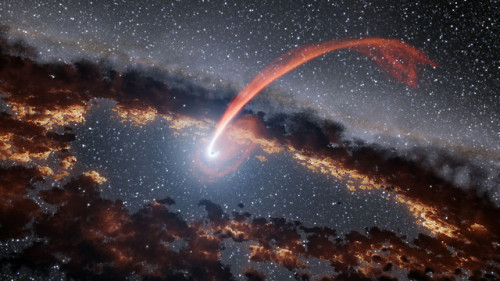🔭🌃🌌🛰
🔭🌃🌌🛰

Astronomers Detect Matter Falling into Black Hole
University of Leicester’s Professor Ken Pounds and co-authors report the detection of matter falling into a black hole at 30% of the speed of light.

It is now well established that a supermassive black hole lies in the center of most galaxies, and further that it accretes matter through a disk.
With sufficient matter (interstellar gas clouds or even isolated stars) falling into the black hole, these can become extremely luminous, and are seen as a quasar or active galactic nucleus (AGN).

The orbit of matter around the black hole is often assumed to be aligned with the rotation of the black hole, but there is no compelling reason for this to be the case. In fact, the reason we have summer and winter is that the Earth’s daily rotation does not line up with its yearly orbit around the Sun.
Until now it has been unclear how misaligned rotation might affect the in-fall of matter. This is particularly relevant to the feeding of supermassive black holes since matter can fall in from any direction.

Using data from ESA’s XMM-Newton X-ray Observatory, Professor Pounds and colleagues looked at X-ray spectra from PG1211+143, a Seyfert galaxy (characterized by a very bright AGN resulting from the presence of the massive black hole at its nucleus) located in the constellation Coma Berenices, about one billion light-years away.

The team found the spectra to be strongly red-shifted, showing the observed matter to be falling into PG1211+143’s black hole at the enormous speed of 30% of the speed of light, or around 62,000 miles per second (100,000 km per second).
The gas has almost no rotation around the black hole, and is detected extremely close to it in astronomical terms, at a distance of only 20 times the black hole’s size (its event horizon, the boundary of the region where escape is no longer possible).
“The galaxy we were observing with XMM-Newton has a 40-million-solar-mass black hole which is very bright and evidently well fed,” Professor Pounds said.

“Indeed some 15 years ago we detected a powerful wind indicating the black hole was being over-fed. While such winds are now found in many active galaxies, PG1211+143 has now yielded another ‘first,’ with the detection of matter plunging directly into the black hole itself.”
“We were able to follow an Earth-sized clump of matter for about a day, as it was pulled towards the black hole, accelerating to a third of the velocity of light before being swallowed up by the hole.” source
More Posts from Monstrous-mind and Others
🐈🍂🍁🐾

@WeHeartIt /entry/27035659
📚📖🍁🍂🌌☕🎃

By Khanh Do


(via 500px / …… by Fabrizio Riccardo Castorina)
🐈🍁🍂

via Fall/Halloween
••• Wake Me Up When September Starts •••

#Cool
What’s Enceladus?
Before we tell you about Enceladus, let’s first talk about our Cassini spacecraft…
Our Cassini mission to Saturn is one of the most ambitious efforts in planetary space exploration ever mounted. Cassini is a sophisticated robotic spacecraft orbiting the ringed planet and studying the Saturnian system in detail.

Cassini completed its initial four-year mission to explore the Saturn System in June 2008. It has also completed its first mission extension in September 2010. Now, the health spacecraft is making exciting new discoveries in a second extension mission!
Enceladus

Enceladus is one of Saturn’s many moons, and is one of the brightest objects in our solar system. This moon is about as wide as Arizona, and displays at least five different types of terrain. The surface is believed to be geologically “young”, possibly less than 100 million years old.
Cassini first discovered continually-erupting fountains of icy material on Enceladus in 2005. Since then, the Saturn moon has become one of the most promising places in the solar system to search for present-day habitable environments.

Scientists found that hydrothermal activity may be occurring on the seafloor of the moon’s underground ocean. In September, it was announced that its ocean –previously thought to only be a regional sea – was global!
Since Cassini is nearing the end of its mission, we are able to make a series of three close encounters with Enceladus, one of Saturn’s moons.
Close Encounters
On Oct. 14, Cassini performed a mid-range flyby of Enceladus, but the main event will take place on Oct. 28, when Cassini will come dizzyingly close to the icy moon. During this flyby, the spacecraft will pass a mere 30 miles above the moon’s south polar region!

This will be the deepest-ever dive through the moon’s plume of icy spray, where Cassini can collect images and valuable data about what’s going on beneath the frozen surface.
Make sure to follow us on Tumblr for your regular dose of space: http://nasa.tumblr.com


cozy autumn days
🍁🍂🌄

-
 wings-scales-fire reblogged this · 2 years ago
wings-scales-fire reblogged this · 2 years ago -
 demondmayhew016 liked this · 2 years ago
demondmayhew016 liked this · 2 years ago -
 intrusivetoxin liked this · 3 years ago
intrusivetoxin liked this · 3 years ago -
 jett-blck liked this · 4 years ago
jett-blck liked this · 4 years ago -
 andrejupiter liked this · 4 years ago
andrejupiter liked this · 4 years ago -
 azurecrucis liked this · 5 years ago
azurecrucis liked this · 5 years ago -
 starryeyedastronaut liked this · 5 years ago
starryeyedastronaut liked this · 5 years ago -
 fractalabomination liked this · 5 years ago
fractalabomination liked this · 5 years ago -
 noisypaintersong reblogged this · 5 years ago
noisypaintersong reblogged this · 5 years ago -
 eugenia-virginia reblogged this · 5 years ago
eugenia-virginia reblogged this · 5 years ago -
 fawndoe19 liked this · 5 years ago
fawndoe19 liked this · 5 years ago -
 petalsandeverythingnice reblogged this · 5 years ago
petalsandeverythingnice reblogged this · 5 years ago -
 petalsandeverythingnice liked this · 5 years ago
petalsandeverythingnice liked this · 5 years ago -
 profoundtoadshepherdapricot-blog liked this · 5 years ago
profoundtoadshepherdapricot-blog liked this · 5 years ago -
 escapingtheirony liked this · 5 years ago
escapingtheirony liked this · 5 years ago -
 nebbytheartist liked this · 5 years ago
nebbytheartist liked this · 5 years ago -
 emorgan5061 liked this · 5 years ago
emorgan5061 liked this · 5 years ago -
 desdinovasupervillain liked this · 5 years ago
desdinovasupervillain liked this · 5 years ago -
 noisypaintersong liked this · 5 years ago
noisypaintersong liked this · 5 years ago -
 spookydisasteronmain liked this · 5 years ago
spookydisasteronmain liked this · 5 years ago -
 boredblackbird liked this · 5 years ago
boredblackbird liked this · 5 years ago -
 m-l-e-p liked this · 5 years ago
m-l-e-p liked this · 5 years ago -
 krdiboy-blog-blog liked this · 5 years ago
krdiboy-blog-blog liked this · 5 years ago -
 theministryofmorons liked this · 5 years ago
theministryofmorons liked this · 5 years ago -
 smallfryingpan liked this · 5 years ago
smallfryingpan liked this · 5 years ago -
 acmkvhd liked this · 5 years ago
acmkvhd liked this · 5 years ago -
 ashacrone reblogged this · 5 years ago
ashacrone reblogged this · 5 years ago -
 ashacrone liked this · 5 years ago
ashacrone liked this · 5 years ago -
 i-was-supposed-to-have-a-twin liked this · 5 years ago
i-was-supposed-to-have-a-twin liked this · 5 years ago -
 metalzoic liked this · 5 years ago
metalzoic liked this · 5 years ago -
 shewhotore liked this · 5 years ago
shewhotore liked this · 5 years ago -
 kneipho liked this · 5 years ago
kneipho liked this · 5 years ago -
 missadorable96 liked this · 5 years ago
missadorable96 liked this · 5 years ago -
 namelessismyprice reblogged this · 5 years ago
namelessismyprice reblogged this · 5 years ago -
 headspacedad reblogged this · 5 years ago
headspacedad reblogged this · 5 years ago -
 fagdykefrank liked this · 5 years ago
fagdykefrank liked this · 5 years ago -
 jasper-dreams-defunct reblogged this · 5 years ago
jasper-dreams-defunct reblogged this · 5 years ago -
 jasper-dreams-defunct liked this · 5 years ago
jasper-dreams-defunct liked this · 5 years ago -
 alightheartedsideblog reblogged this · 5 years ago
alightheartedsideblog reblogged this · 5 years ago -
 determinedtoaster liked this · 5 years ago
determinedtoaster liked this · 5 years ago
My ambition is handicapped by laziness. -C. Bukowski Me gustan las personas desesperadas con mentes rotas y destinos rotos. Están llenos de sorpresas y explosiones. -C. Bukowski. I love cats. Born in the early 80's, raised in the 90's. I like Nature, Autumn, books, landscapes, cold days, cloudy Windy days, space, Science, Paleontology, Biology, Astronomy, History, Social Sciences, Drawing, spending the night watching at the stars, Rick & Morty. I'm a lazy ass.
222 posts